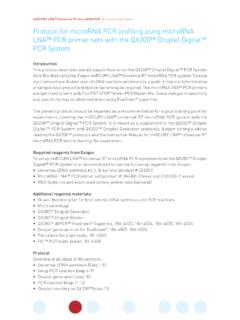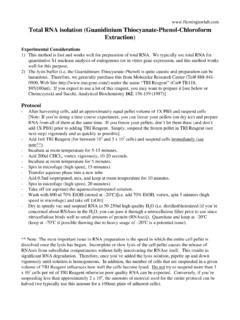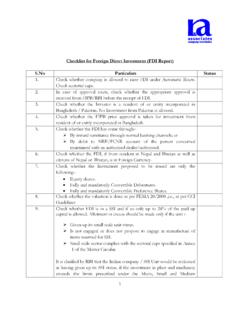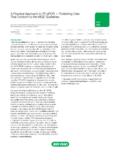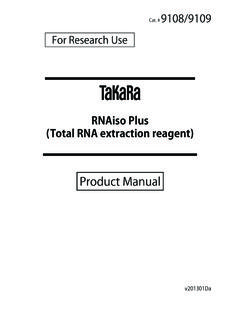Transcription of miRCURY™ RNA Isolation Kit - Biofluids
1 mircury RNA Isolation Kit -BiofluidsInstruction manual #300112 and #300113 November 2015 Isolation2miRCURY RNA Isolation Kit - Biofluids Instruction ManualProduct summary .. 3miRCURY RNA Isolation Kit Biofluids contents .. 3 Additional required materials, not supplied .. 3 Product description .. 4 Storage and product stability .. 6 Protocol overview .. 7 Before starting the experiment .. 7 Protocol & Notes .. 8 General recommendations for working with Biofluids .. 8 Notes prior to use .. 9 Section A.
2 Standard protocol for RNA Isolation .. 14 Section B. RNA Isolation using a vacuum manifold .. 17 Tips and Troubleshooting .. 21 Appendix A .. 23 Protocol for Optional On-column DNA Removal .. 23 Related products .. 24 Further reading .. 26 Table of Contents3miRCURY RNA Isolation Kit - Biofluids Instruction ManualmiRCURY RNA Isolation Kit Biofluids contentsThe mircury RNA Isolation Kit Biofluids consists of the components described in Table 1 .Additional required materials, not supplied Benchtop microcentrifuge Pipette (+ RNase-free tips) Vortexer 99% ethanol Isopropanol Proteinase K (optional) MS2 RNA (Highly recommended, for increased reproducibility) , Roche, cat.
3 No . 10165948001 RNA Spike-In Kit (#203203), optional for quality control of extraction efficiencyKit Components50 isolations10 isolationsLysis Solution BF13 mL13 mLProtein Precipitation Solution BF5 mL5 mLReaction buffer for rDNase7 mL7 mLrDNase, RNase-free (lyophilized)1 vial *1 vial *Wash Solution 1 BF10 mL 10 mL Wash Solution 2 BF (Concentrate)25 mL **6 mL **RNase-Free Water13 mL13 mLmicroRNA Mini Spin Columns BF5010 Collection Tubes (1 .5 mL)5010 Collection Tubes (2 mL)5010 Collection Tubes with lid (2 mL)5010 Table 1.
4 * For preparation of working solution see Protocol & notes . ** Add 100 mL 99% ethanol . ** Add 24 mL 99% ethanol .Note: In order to streamline manufacturing we have changed bottles from square to round and volumes have been modified slightly . Content is unchanged .Product summary4miRCURY RNA Isolation Kit - Biofluids Instruction ManualProduct descriptionExiqon s mircury RNA Isolation Kit Biofluids provides a rapid method for the Isolation and purification of RNA from serum, plasma and other Biofluids like cerebrospinal fluid or urine (for kit specifications see Table 2).
5 The kit can be used for the purification of all RNAs smaller than 1000 nt, from mRNA and tRNA down to microRNA and small interfering RNA (siRNA) . The purification is based on spin column chromatography using a proprietary resin as the separation matrix . Small RNAs are separated from other cellular components such as proteins, without the use of phenol or chloroform in 40-70 minutes . The kit can be used to isolate high quality RNA in amounts sufficient for qPCR analysis using the mircury LNA Universal RT microRNA PCR system.
6 The protocol consist of 5 simple steps (see also Figure 1):1 . Biofluid components are lysed with the provided Lysis Solution 2 . Proteins are precipitated with the provided Protein Precipitation Solution3 . Isopropanol is added to the collected supernatant and the solution is loaded to the column with an option for an on-column DNase digestion4 . The solution is washed with Wash Solutions 1 and 25 . The RNA is eluted with RNase free water5miRCURY RNA Isolation Kit - Biofluids Instruction ManualIn the first part of the RNA Isolation process, membranized particles/cells are lysed using the provided Lysis Solution (Figure 1).
7 Proteins are precipitated using the precipitation solution and isopropanol is then added to the transferred supernatant . This solution is loaded onto a spin-column . The resin binds RNA in a manner that depends on ionic concentrations . Thus only the RNA will bind to the column, while the residual proteins will be removed in the flow-through or retained on the top of the resin . The bound RNA is then washed with the provided Wash Solution I and II in order to remove any remaining impurities, and the purified small RNA is eluted with RNase free water.
8 SpinSpinSpinSpinLysisPrecipitationTransf er supernatantAdd Isopropanol and add to columnWash 3 times with wash solutionsElute RNA with RNase-free waterPurified small RNAF igure 1. Protocol over view of the mircury RNA Isolation Kit Biofluids .6miRCURY RNA Isolation Kit - Biofluids Instruction ManualStorage and product stability Lyophilized rDNase should be stored at -20 C upon arrival . Storage of lyophilized rDNase at room temperature is not critical .All other solutions should be kept tightly sealed and stored at room temperature.
9 These reagents should remain stable for at least 6 months in their unopened containers .Kit SpecificationsColumn Binding Capacity200 g Maximum Column Loading Volume800 LSize of RNA Purified all RNA < 1000 ntMaximum volume of Starting Material supported9 0 0 L*Recommended volume of Starting Material200 L Elution volume20-50 LTime to complete 10 Purifications40 min (70 min with optional DNase digestion) Ensure that a suitable lab coat, disposable gloves and protective goggles are worn and standard safety precautions are followed when working with chemicals.
10 Guanidine Thiocyanate contained in the Lysis Solution BF and in Wash Solution 1 BF is an irritant . For more information, please consult the appropriate Material Safety Data Sheets (MSDSs) . Biofluids like serum or plasma of all human and animal subjects are considered potentially infectious . All necessary precautions recommended by the appropriate authorities in the country of use should be taken when working with Biofluids .Important note - CautionsTable 2 .* requires volume adjustment of Lysis Solution, Protein Precipitation Solution and Isopropanol.
